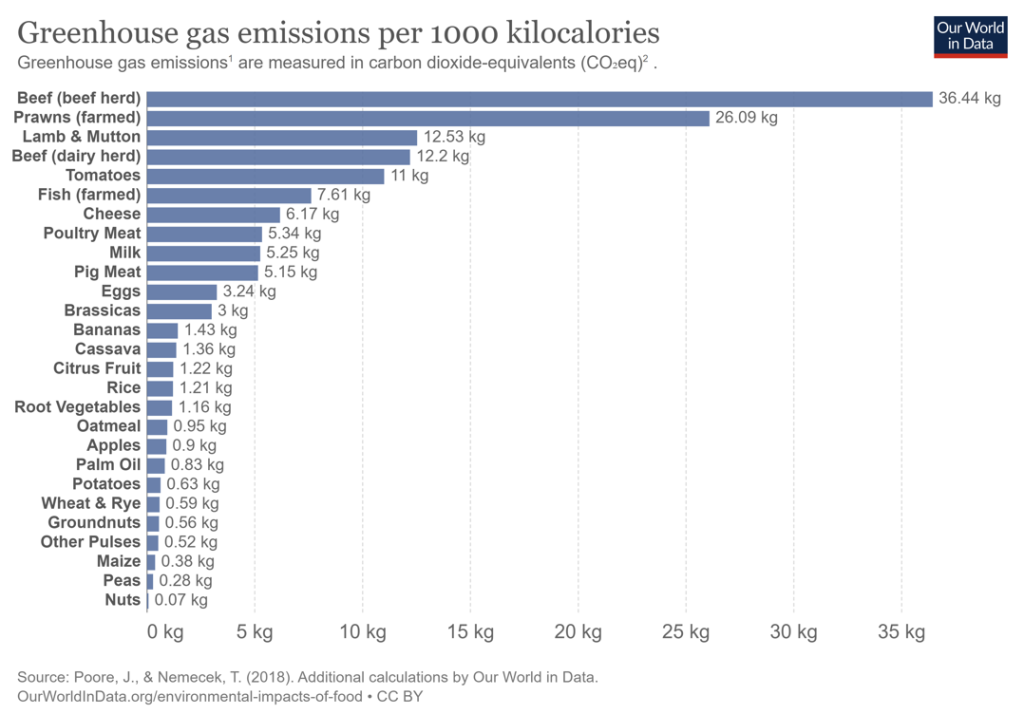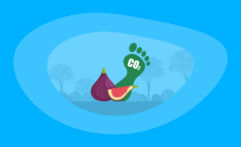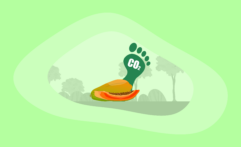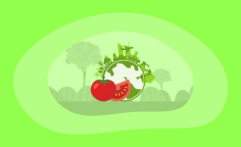What Is the Carbon Footprint of Plums? A Life-Cycle Analysis
Impactful Ninja is reader-supported. When you buy through links on our site, we may earn an affiliate commission.
Learn more
Learn more
.
Hey fellow impactful ninja ? You may have noticed that Impactful Ninja is all about providing helpful information to make a positive impact on the world and society. And that we love to link back to where we found all the information for each of our posts. Most of these links are informational-based for you to check out their primary sources with one click. But some of these links are so-called "affiliate links" to products that we recommend. First and foremost, because we believe that they add value to you. For example, when we wrote a post about the environmental impact of long showers, we came across an EPA recommendation to use WaterSense showerheads. So we linked to where you can find them. Or, for many of our posts, we also link to our favorite books on that topic so that you can get a much more holistic overview than one single blog post could provide. And when there is an affiliate program for these products, we sign up for it. For example, as Amazon Associates, we earn from qualifying purchases. First, and most importantly, we still only recommend products that we believe add value for you. When you buy something through one of our affiliate links, we may earn a small commission - but at no additional costs to you. And when you buy something through a link that is not an affiliate link, we won’t receive any commission but we’ll still be happy to have helped you. When we find products that we believe add value to you and the seller has an affiliate program, we sign up for it. When you buy something through one of our affiliate links, we may earn a small commission (at no extra costs to you). And at this point in time, all money is reinvested in sharing the most helpful content with you. This includes all operating costs for running this site and the content creation itself. You may have noticed by the way Impactful Ninja is operated that money is not the driving factor behind it. It is a passion project of mine and I love to share helpful information with you to make a positive impact on the world and society. However, it's a project in that I invest a lot of time and also quite some money. Eventually, my dream is to one day turn this passion project into my full-time job and provide even more helpful information. But that's still a long time to go. Stay impactful,Affiliate Disclosure
Why do we add these product links?
What do these affiliate links mean for you?
What do these affiliate links mean for us?
What does this mean for me personally?
![]()
With over 200 varieties cultivated in the US, the plum is one of the most popular and diverse native North American fruits. They are also an excellent source of vitamins A, C, and K, with relatively few calories per unit! But have you ever thought of the potential environmental impact of plums? If you are a regular plum consumer, then you should think about their potential carbon emissions. So, we had to ask: What is the carbon footprint of plums?
Plums have a carbon footprint of 0.4 kg (0.88 lbs) CO2e per pound of plums. This is mainly because of their high rates of land use, irrigation, pesticides, harvesting methods, packaging, and transportation times. They are among the highest carbon-emitting fruits on the carbon footprint scale.
In this article, we will look at the full life cycle of the plum, investigating how each stage contributes to its carbon footprint. We will go through each of the main stages of the plum’s production, starting with growth and going through harvesting, distribution, and ending at waste disposal. Through each of these sections, we will evaluate how it contributes to the plum’s carbon footprint to determine the overall impact of the plum. So, let’s get into the carbon footprint of the plum!
Here’s How We Assessed the Carbon Footprint of Plums
The carbon footprint is one of the ways we measure the effects of our human-induced global climate change. It primarily focuses on the greenhouse gas (GHG) emissions associated with consumption, but also includes other emissions such as methane (CH4), nitrous oxide, and chlorofluorocarbons, and is generally expressed in carbon dioxide equivalents (CO2e).
“Carbon footprint: the amount of greenhouse gases and specifically carbon dioxide emitted by something (such as a person’s activities or a product’s manufacture and transport) during a given period”
Merriam Webster
Basically, it is the amount of carbon emitted by you as an individual or an organization providing you with goods and services – including plums:
- This includes GHG emissions from producing the products that we use and foods that we eat (e.g., power plants, factories or farms, and landfills)
- GHG emissions from fuel that we burn directly or indirectly (e.g., logistics and transportation, cooling or heating facilities),
- as well as the GHG emissions attributed to how we consume these products and foods.
To understand the carbon footprint of plums, we must assess its life-cycle and each stage’s sustainability. This life-cycle assessment (LCA) is a method to evaluate the environmental impacts of products and materials.
Here’s the Overall Carbon Footprint of Plums
The overall carbon footprint of plums is 0.4 kg (0.88 lbs) CO2e per pound of plums. There are many factors that contribute to this large carbon footprint, including the amount of irrigation, land, and pesticides used, as well as the mechanized harvesting practices and the improper disposal of waste. In general, plums have a high carbon footprint, especially in comparison to other fruits.
Plums are a delicious treat, but there are quite a few aspects of their production process that can drive up their carbon footprint. From the methods used in their harvesting to how far they need to travel to your door to the way that most people tend to dispose of them. So, let’s examine how all these factors combine to form the overall carbon footprint of the plum.
| The carbon footprint of plums | 0.4 kg (0.88 lbs) CO2e per pound of plums |
So, let’s have a look at each stage of the LCA of plums!
| The life-cycle stages of plums | Each stage’s carbon footprint |
| Growing of plums | The growth of plums has a fairly high carbon footprint. This is largely due to their lower-density orchards, irrigation requirements, and high pesticide use. |
| Harvesting, processing, and packaging of plums | The carbon footprint of harvesting, processing, and packaging plums is significant. This is mainly due to the fact that most of the process is mechanized and the packaging uses cardboard. |
| Transporting of plums | The transportation carbon footprint of plums is fairly high. The main factors that contribute to this are the average distances traveled and the need to refrigerate the fruit during transportation. Most of the plums consumed in the US are grown in California, however, a significant number are also imported from Chile. |
| End-of-life of plums | The end-of-life disposal of plum waste contributes significantly to its carbon footprint. The main reason for this is the lack of consistent composting amongst the average plum consumer. |
Those are the bigger summaries of each stage of the plum’s impact, illustrating for you how they contribute to the carbon footprint. But each of those categories has a more complex story to tell. In the ensuing sections, we will dive deeper into the more specific qualities of these aspects of the plum production process.
What Is the Carbon Footprint of Growing Plums
The growth of plums has a fairly high carbon footprint. This is largely due to their lower-density orchards, irrigation requirements, and high pesticide use.
Plums are actually native to America and Canada, meaning they have been growing on this continent for thousands of years. To this day, they remain a staple in the harvest season. But the process of growing fruit can actually have a relatively high carbon footprint, depending on the methods used. Factors like the amount of water used, deforestation, and pesticides can all contribute to the overall impact of the growth stage. Here, we will look at how these factors work within the plum industry.
Which factors impact the carbon footprint of growing plums?
- How do plums grow: Plums grow on trees, which means that at least part of their carbon footprint is offset because trees have carbon-storing properties. They are best suited to the cool winters and hot summers of the North American continent.
- What is the growth duration of plums: Plums have a relatively short growth period, taking only about two to three months to ripen from the blossom. However, their ripe time is also short, meaning that they need to be picked within about two weeks of ripening or they will go to waste. This can significantly impact the overall carbon footprint of plums.
- What is the land usage of plums: Plum farms can typically fit about 275 plum trees per hectare. This is between apples (250 trees per hectare) and lemons (300 trees per hectare), and far less than peaches (350 trees per hectare) on the density scale. Since fewer plum trees can fit in each hectare, more land is required to produce the same amount of plums, which drives up their carbon footprint.
- What is the water usage of plums: Plums need about an inch of water every week, or around 52 inches of water per year. Most plums grown in the US are grown in California, which only gets about 22 inches of water per year. So, significant irrigation is needed for over half of the plum’s water needs. Irrigation uses a lot of resources and thus drives up the carbon footprint of plums.
- What is the pesticide and fertilizer usage of plums: Plums tend to use a lot of pesticides, being in the top 20 worst pesticide offenders. Pesticides are actually significant carbon emitters, meaning that plums’ pesticide use contributes significantly to their carbon footprint.
Plums grown on trees that pull carbon from the atmosphere. However, the carbon footprint of growing plums is still relatively high because they need large amounts of water and pesticides to grow successfully.
In short, the carbon footprint of growing plums is significant, contributing heavily to its overall carbon footprint. The main areas that contribute to the overall carbon footprint are the low-dense orchards requiring more space, the irrigation required, and the high pesticide use.
What Is the Carbon Footprint of Harvesting, Processing, and Packaging Plums
The carbon footprint of harvesting, processing, and packaging plums is significant. This is mainly due to the fact that most of the process is mechanized and the packaging uses cardboard.
The next major stage in the plum growth process is harvesting, processing, and packaging. This stage is very important, and if certain factors are in place, can actually contribute greatly to the carbon footprint of the fruit. So, let’s see how the process of harvesting, processing, and packaging plums affects their carbon footprint.
Which factors impact the carbon footprint of harvesting, processing, and packaging plums?
- How are plums harvested: Plums can be picked by hand, but they are typically picked mechanically. Specialized machines shake the tree and allow the plums to fall into a catcher, a process known as shake and catch. These machines require energy to run, and so this stage in the process contributes significantly to the plum’s carbon footprint.
- How are plums processed: The processing method of plums depends on whether those plums are bound to be prunes or eaten fresh. For the fresh plums, they are sorted based on appearance and quality. Much of this process is also automated, which uses energy and thus drives up the carbon footprint of plum processing.
- How are plums packaged: Plums are typically packaged in corrugated cardboard containers with sections for each fruit. Since cardboard actually emits a significant amount of carbon in its production process, this packaging has a negative effect on plums’ carbon footprint.
From this data, it is clear that the production process of plums, from harvesting to packaging, has a significant carbon footprint. Many factors, including the automation of most of the process, as well as the cardboard used in the packaging, mean that this stage of the process contributes greatly to the overall carbon footprint of plums.
In short, plums release a significant amount of carbon emissions through their processing stage alone. Mechanized processes during picking and sorting combined with cardboard packaging are the biggest contributors to their carbon footprint.
What Is the Carbon Footprint of Transporting of Plums
The transportation carbon footprint of plums is fairly high. The main factors that contribute to this are the average distances traveled and the need to refrigerate the fruit during transportation. Most of the plums consumed in the US are grown in California, however a significant number are also imported from Chile.
A Plums’ journey has just started when they are packaged. Then, they have to travel the distance between the farm and the grocery store. The distance, as well as the method through which they have to travel, are the two most important factors in determining the footprint of their transportation. So, let’s see how the transportation of plums contributes to their overall carbon footprint.
Which factors impact the carbon footprint of transporting plums?
- Where are plums grown: Plums consumed in the US are grown primarily in California. However, the US also imports a significant amount of their plums from Chile. Thus, the carbon footprint of the transportation of your plums will depend on whether you buy imported or domestic plums and how far you live from California.
- How are plums transported: Plums can ripen too fast during the transportation process if they are not kept cool. Ideally, plums should be stored at around 2 degrees celsius (35.6F) to maintain their freshness. This means that the transportation containers, either in trucks, if they are coming from California, or shipping containers, if they are coming from Chile, need to be kept at this temperature. Refrigerated trucks and shipping containers use significantly more energy than non-temperature-controlled ones, which drives up the carbon footprint.
Shipping plums has a fairly significant effect on their carbon footprint, but this all depends on whether you are buying domestic or imported. Most Americans buy domestic plums, but since the eastern half of the country is more populous than the western half, many are still buying plums that come from across the country, which drives up their carbon footprint.
In short, transportation contributes significantly to the carbon footprint of the plum. Significant travel distances across the country and refrigerated trucks contribute the most to their emissions.
What Is the Carbon Footprint of the End-of-Life of Plums
The end-of-life disposal of plum waste contributes significantly to its carbon footprint. The main reason for this is the lack of consistent composting amongst the average plum consumer.
The plum carbon footprint journey isn’t done after you consume them. In fact, one of the most important factors that will determine the overall carbon footprint of the plum is how its waste is disposed of. Here, we will look at how this stage in the process affects the plum’s carbon footprint.
Which factors impact the carbon footprint of the end-of-life of plums?
- How are plums disposed of: All of the plum’s waste, including the pit, is biodegradable. However, only about 4% of compostable materials are actually composted, meaning that most simply go to landfills. Furthermore, throwing food waste in landfills generates methane, which is a very harmful greenhouse gas. So not only is the waste not being composted, it is also causing additional harm to the environment.
- How is the packaging of plums disposed of: Plums sometimes come in cardboard boxes. But, since cardboard has the highest recycling rate of any recyclable material at 89%, the packaging is unlikely to end up in landfills, meaning that packaging does not contribute significantly to the overall carbon footprint of the plum.
Despite there being potential for a more carbon-conscious waste disposal plan, the current statistics show that fruit disposal contributes significantly to climate change. Since plums are generally not disposed of in the most environmentally-friendly ways, this stage of the process contributes significantly to their carbon footprint.
In short, waste disposal is a significant contributor to the overall carbon footprint of the plum. The fact that food and paper waste are generally not composted or recycled means that plums contribute significantly to landfills.
How Does the Carbon Footprint of Plums Compare to Other Types of Food
In comparison to most other foods, plums have a relatively large carbon footprint, especially in comparison to other fruits. Essentially, there are many more carbon-conscious choices than plums, like pineapples, but there are still choices that are a lot worse for the planet, like beef.
When assessing the carbon footprint of a particular food, it is always important to place it in the context of other foods. This can help you to see the relative impact they have and assist you in making decisions between different foods based on their carbon footprint. In this next part of the article, we will show you how plums compare to other foods in terms of carbon footprint.
How Does the Carbon Footprint of Plums Compare to Other Types of Fruits
Fruits in general, tend to have lower carbon footprints than many other foods, like dairy products. However, there is still a lot of variation between them. Different transportation distances, the density of orchards, variations in growing methods, and pesticide use can all add up to contribute to their carbon footprints. Here, we will look at how plums compare specifically to other fruits in terms of carbon footprint.
| Fruits | Carbon Footprint per lbs | Calories per lbs | Carbon Footprint per Calories |
| Avocados | 0.85 kg (1.9 lb) of CO2e per pound of avocados | 725 calories per pound | 1.17kg (2.57lb) of CO2e per 1,000 calories of avocados |
| Grapes | 0.64 kg (1.42 lbs) of CO2e per pound of grapes | 300 calories per pound | 2.13kg (4.7lb) of CO2e per 1,000 calories of grapes |
| Cantaloupes | 0.58kg (1.3lb) of CO2e per pound of cantaloupe | 154 calories per pound | 3.77kg (8.31lb) of CO2e per 1,000 calories of cantaloupes |
| Kiwis | 0.56kg (1.24lb) of CO2e per pound of kiwis | 277 calories per pound | 2.02kg (4.45lb) of CO2e per 1,000 calories of kiwis |
| Blueberries | 0.45kg (1lb) of CO2e per pound of blueberries | 256 calories per pound | 1.75kg (3.86lb) of CO2e per 1,000 calories of blueberries |
| Plums | 0.4 kg (0.88 lb) CO2e per pound of plums | 209 calories per pound | 1.91kg (4.21lb) of CO2e per 1,000 calories of plums |
| Strawberries | 0.39kg (0.88lb) of CO2e per pound of strawberries | 145 calories per pound | 2.69kg (5.93lb) of CO2e per 1,000 calories of strawberries |
| Pomegranates | 0.39kg (0.87lb) of CO2e per pound of pomegranates | 375 calories per pound | 1.04kg (2.29lb) of CO2e per pound of pomegranates |
| Figs | 0.3kg (0.68lb) of CO2e per pound of figs | 333 calories per pound | 0.9kg (1.98lb) of CO2e per 1,000 calories of figs |
| Papayas | 0.3kg (0.67lb) of CO2e per pound of papayas | 195 calories per pound | 1.54kg (3.4lb) of CO2e per 1,000 calories of papayas |
| Oranges | 0.3kg (0.66 lb) CO2e per pound of oranges | 213 calories per pound | 1.41kg (3.11lb) of CO2e per 1,000 calories of oranges |
| Dates | 0.27kg (0.6lb) of CO2e per pound of dates | 1,300 calories per pound | 0.21kg (0.46lb) of CO2e per 1,000 calories of dates |
| Apples | 0.24 kg (0.53 lb) of CO2e per pound of apples | 236 calories per pound | 1.02kg (2.25lb) of CO2e per 1,000 calories of apples |
| Pears | 0.23kg (0.52 lb) of CO2e per pound of pears | 259 calories per pound | 0.89kg (1.96lb) of CO2e per 1,000 calories of pears |
| Bananas | 0.21 kg (0.48 lb) of CO2e per pound of banana | 404 calories per pound | 0.52kg (1.15lb) of CO2e per 1,000 calories of bananas |
| Mangoes | 0.21 kg (0.46 lb) CO2e per pound of mangoes | 272 calories per pound | 0.77lb (1.7lb) of CO2e per 1,000 calories of mangoes |
| Cherries | 0.19kg (0.41 lb) of CO2e per pound of cherries | 227 calories per pound | 0.84kg (1.85lb) of CO2e per 1,000 calories of cherries |
| Limes | 0.18kg (0.39lb) of CO2e per pound of limes | 136 calories per pound | 1.32kg (2.91lb) of CO2e per 1,000 calories of limes |
| Peaches | 0.17kg (0.38lb) CO2e per pound of peaches | 176 calories per pound | 0.97kg (2.14lb) of CO2e per 1,000 calories of peaches |
| Apricots | 0.16kg (0.36lb) of CO2e per pound of apricots | 218 calories per pound | 0.73kg (1.61lb) of CO2e per 1,000 calories of apricots |
| Raspberries | 0.15kg (0.33lb) of CO2e per pound of raspberries | 240 calories per pound | 0.63kg (1.39lb) of CO2e per 1,000 calories of raspberries |
| Pineapples | 0.09 kg (0.20 lb) of CO2e per pound of pineapple | 227 calories per pound | 0.4kg (0.88lb) of CO2e per 1,000 calories of pineapples |
| Lemons | 0.09kg (0.19lb) CO2e per pound of lemons | 132 calories per pound | 0.68kg (1.5lb) of CO2e per 1,000 calories of lemons |
| Grapefruit | 0.08kg (0.18lb) of CO2e per pound of grapefruit | 191 calories per pound | 0.42kg (0.93lb) of CO2e per 1,000 calories of grapefruits |
| Blackberries | 0.07kg (0.15lb) of CO2e per pound of blackberries | 195 calories per pound | 0.36kg (0.79lb) of CO2e per 1,000 calories of blackberries |
| Clementines | 0.06 kg (0.13 lb) CO2e per pound of clementines | 213 calories per pound | 0.28kg (0.62kg) of CO2e per 1,000 calories of clementines |
| Watermelons | 0.05kg (0.11 lb) of CO2e per pound of watermelon | 136 calories per pound | 0.37kg (0.82lb) of CO2e per 1,000 calories of watermelons |
As we can see from this chart, plums actually have a fairly large carbon footprint in comparison to other fruits. While they emit less than half of the carbon emitted by avocados—they still emit around four times as much carbon as lemons, pineapples, bananas, and strawberries. This means that if you are choosing a fruit to eat, plums might not be the most carbon-conscious choice. However, they are still significantly better than the highest emitter.
How Does the Carbon Footprint of Plums Compare to Other Types of Food in General
Branching outside the world of fruit, plums also have a place among food in general. As a fruit, it is going to be on the lower end, but that doesn’t mean it is necessarily the lowest. Here, we will look at how plums compare to the greater category of all foods.
When it comes to greenhouse gas emissions (GHG), foods are often compared in terms of emissions per 1,000 kilocalories (as opposed to their weight in lbs or kg).

Since plums are fairly similar to citrus fruit on the scale of carbon footprint, we can see from this chart that they rank roughly in the middle of the scale of foods in general. They are not as high as most meats, such as beef or lamb, but they still have a significant standing amongst foods in general. Other fruits, as well as grains like corn and wheat, are significantly better carbon-conscious choices.
How Can You Reduce and Offset Your Personal Carbon Footprint
There are many things you can do to cut down on how your plum consumption impacts the planet. Between carefully considering your consumption habits to reduce carbon emissions, and offsetting your carbon through carbon-extraction schemes, you can consume plums without having a large negative impact on the earth.
Some of the carbon risks of plums highlighted in this article may sound a bit alarming. However, the good news is that there are actually a lot of things you can do to lower your carbon emissions while still eating plums. Purchasing organic or locally grown plums and disposing of the waste efficiently can help with this. Furthermore, you can consider emission offsets, which work to extract carbon from the atmosphere. Here, we will walk you through how to accomplish both of these things.
How Can You Reduce Your Carbon Footprint When Shopping for Plums
Before you start worrying about your offsets, you might be wondering how you can stop producing carbon in the first place through your plum consumption. In this section, we will give you a short list of things you can do to continue consuming plums without the high carbon price tag.
- Buy local plums: One of the best ways to reduce your carbon consumption is to reduce one of the biggest contributors to a fruit’s footprint: transportation. If you make sure that the plums you are consuming come from as close a farm as possible, or at least from within the US, you will be reducing your impact by quite a bit. If you live in California, this will be easy, but if you live on the east coast, you can always try buying plums from farmer’s markets, which tend to be much more local.
- Buy organic plums: Plums have a relatively high pesticide rate but organic plums don’t use pesticides. So, they have a much lower carbon footprint. Of course, buying both organic and local plums is the best choice to optimize your carbon footprint.
- Compost and recycle: Another major contributor to the plum’s carbon footprint is improper waste disposal. Make sure that you compost all organic waste and recycle all paper waste to prevent them from ending up in landfills. If you don’t have a government-run composting or recycling program in your area, consider making your own compost and using cardboard as roughage.
- Grow your own: If you live in North America, then you’re in luck, because plum trees grow very well in most regions of the continent. They will also grow in any other climates with similar temperature statistics to anywhere in North America, such as Europe and Asia. Plum trees produce about 40 pounds of plums a year. Since you won’t be transporting them or using pesticides, and will be picking them by hand, you will virtually eliminate your plum carbon footprint altogether!
Following some of these methods can really help you to cut down on your plum carbon emissions. None of these will bring your emissions down to zero, since there are always hidden carbon costs that may be outside of your control. But reduction is always better than nothing! However, if you do want to get your plum emissions down to absolute zero, then you can look into carbon offsets.
How Can You Offset Your Personal Carbon Footprint
Carbon offsets are reductions in carbon emissions that are used to compensate for carbon emissions occurring elsewhere – for example for the carbon emissions that are associated with plums. They are measured in tons of CO2 equivalents and are bought and sold through international brokers, online retailers, and trading platforms on what is known as the global carbon offset market.
“Carbon Offset: a way for a company or person to reduce the level of carbon dioxide for which they are responsible by paying money to a company that works to reduce the total amount produced in the world, for example by planting trees”
Oxford Dictionary
In terms of plums – and indeed all food types – there will always be a carbon footprint, because of the resources it takes to get your food from farms to the place where you’ll eventually eat them. And while there are ways to reduce your carbon footprint when shopping for plums, carbon offsets would be a way to reduce your CO2e emissions all the way down to net zero (or even to become climate positive).
However, when you purchase carbon offsets, it’s important that they actually make a difference in offsetting (aka reducing) total carbon emissions. To achieve that, the following are key criteria:
- Carbon offset projects have to be effective (different projects have different effectiveness rates)
- Carbon offset projects have to be additional
- Carbon offset projects have to be permanent
- The claims from carbon offset projects have to be verifiable
To find the best carbon offsets for you personally, check out our full guide on the best carbon offsets for individuals, where you’ll also learn more about how these carbon offset projects work, what their respective offsetting costs are, and what your best way would be to offset your own carbon emissions.
Final Thoughts
Plums are not the most carbon conscious of fruits. In almost every stage of the process, they emit a significant amount of carbon. Their use of land, irrigation, and pesticides greatly bumps them up during the growing stage, the mechanized harvesting process and cardboard packaging increases their footprint in the processing stage, their moderate transportation times can drive their footprint up in the transport stage, and their tendency to end up in landfills along with their packaging increases their emissions in the final stage.
Overall, plums are one of the less carbon-conscious fruits, but there are still a number of ways, through reduction and offsets, that you can enjoy plums carbon-free!
Stay impactful,

Sources
- Minneton, KA Orchards: American Plum
- Healthline: Nutritional Benefits of Plums
- Britannica: Carbon footprint
- Science Direct: Life-cycle assessment (LCA)
- MIT SMR: Strategic Sustainability Uses of Life-Cycle Analysis
- Science Direct: Environmental Life Cycle Assessment of Apples, Sweet Cherries, and Plums
- Frontiers: Appraisal of Carbon Capture, Storage, and Utilization Through Fruit Crops
- Rosy’s Farm: Plum Farming
- Village Harvest: Harvesting Plums
- Rootstocks: Apple
- Alimpo: Carbon Footprint of the Lemon
- PSU: Peach Production
- Plant Me Green: Plum Planting
- Footprint: Plums
- OEHHA: California Climate
- Pesticide.org: Pesticides and the Climate Crisis
- California Prunes: Growing and Harvesting
- Frumaco: Shake Catch Harvester
- Futura: Plum Sorting and Grading Machine
- Frutas: Plum Packaging
- Consumer Ecology: Carbon Footprint of a Cardboard Box
- ACMRC: Plums
- Cargo Handbook: Plums
- NCBI: Refrigerated Vans
- NASA: United States Population Density
- EPA: Reducing the Impact of Wasted Food
- GOV.BC: Waste Management
- Also Known As: Packaging Waste and Disposal
- Impactful Ninja: What is the Carbon Footprint of Avocados
- Helabel: Kiwis
- Impactful Ninja: What is the Carbon Footprint of Oranges
- Impactful Ninja: What is the Carbon Footprint of Apples
- Impactful Ninja; What is the Carbon Footprint of Peaches
- Helabel: Strawberries
- Co2 Everything: Bananas
- Researchgate: Pineapple
- Impactful Ninja: What is the Carbon Footprint of Lemons
- Our World in Data: Greenhouse Gas Emissions per 1000 kilocalories
- Gardening Knowhow: Composting
- Raintree Nursery: Growing Plum Trees
- Plan Your Patch: How Much Fruit Does a Plum Tree Produce
- Impactful Ninja: 12 Best Carbon Offsets for Individuals




